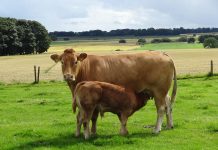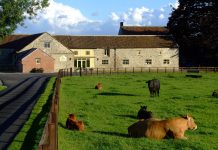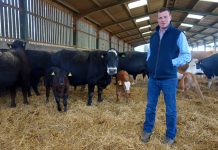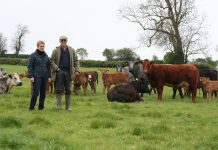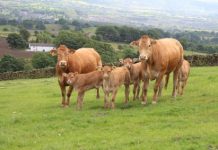Stephen Graham’s hill farm is heavily stocked and he only has one full-time member of staff to help him. He has chosen the Limousin as the dominant breed for his commercial herd, due to its ease of management and ability to survive under harsh conditions; the farm is in a high rainfall area, with the land at 700-800 feet above sea-level.

The Graham Family includes Stephen’s wife, Tracey, who runs an outside catering business, and their two daughters, eleven-year old Rachael and Amy, aged eight. His father, Martin, and mother, Sheila, are also involved in the business, which supports a flock of 1,000 breeding ewes, as well as the cattle. Cattle breeding is in Stephen’s blood, as his grandfather, Joe Graham, was a noted producer of Blue-Greys and is still remembered today for the quality of his herd.
Limousin-based suckler herd and finishing unit
The family farm has been expanded in recent years, with the purchase of a second holding next door and two new tenancy agreements signed for farms close by, taking the total acreage to around 1,000. The suckler herd is made up of 140 cows, which are mainly three-quarter Limousin with some British Blue bloodlines. These are put to one of the three Limousin stock bulls on the farm, with the best females selected as replacements. In addition, Stephen buys in around 150-200 suckled calves from a variety of sources each year.

There is no fixed marketing policy; cattle are sold at various times of the year, with some going as stores, to ease cash flow. Finished animals are sold on a deadweight basis and the majority go to Woodheads in Lancashire for Morrisons supermarket, although local butchers also take some. Stephen transports his cattle direct to the abattoir in batches of ten, in the belief that it causes less stress for his livestock and keeps the system simple.
Last year saw more than 100 finished steers averaging £1,723 and achieving E, U+ and U- grades, at deadweights ranging from 400-440kgs, while the heifers reached 350-360kgs. Around a dozen animals are sold to fatstock show competitors and this makes a valuable contribution towards boosting annual average prices. Stephen usually sets the money aside and puts it towards his next bull purchase.
Limousins: natural hardy, easy calving and good converters
“The Limousin can cope with our level of rainfall better than other breeds and I think that’s because it comes from the high hills of France, where it has to be hardy in order to survive,” he comments. “The cows are usually easy to calve and the youngstock are good converters of feed. My cows milk reasonably well and this trait is something I want to maintain; it is always a consideration when I am selecting any animal to breed from.
“I am also trying to produce cattle which are consistent in size, as this minimises bullying and reduces disease levels, because a calm animal’s immune system functions better than one which is under pressure.”
Prior to the farm expansion, Stephen regularly bought sheep and cattle to sell to other producers, but lack of time means he now only makes purchases to order. When it comes to buying his own stock, his budget for bulls is 4,000-6,000gns. The current team includes the Cloughead Titanic son, Liscon Braveheart, which was purchased at Carlisle in the summer of 2008 and has thrown some consistently good calves. Some have reached show standard and the best one achieved a price of £3,500, with another at £2,500.
The black Limousin, Knock Black Falcon is also part of the herd, having been spotted at a Carlisle Sale in May 2012.

“I wanted a black Limousin to put to non-Limousin bred females because I was looking to improve ease of calving. Until I found Knock Black Falcon, I hadn’t seen a black bull I particularly fancied, but he seemed to fit the bill. I paid 4,500gns for him, in the hope of improving my live calf figure.
“I only ever give new bulls half a dozen cows, to check the type of calf they are throwing and I will not keep any animal whose calves aren’t up to scratch, no matter how much he has cost. Knock Black Falcon’s progeny have been born relatively small and I have not had to calve any of his cows, so I am pleased with his performance. I will be using him more extensively in the future.
Live calves that are born easily and grow on
“I am no different from other commercial breeders; I want a bull that will give me a calf which is small at birth, but grows to a decent size when it’s older,” he comments. “If you only need one bull, then you can spend more, but I require at least three, as my herd is closed and I aim for a tight calving pattern.
“At one stage, I felt the calves I was breeding were too fine and pretty and they weren’t reaching weight targets; after all it is weight that counts. I have made an effort to move towards a longer animal, with a good shape. A bull must not be too heavy in the shoulder and I like a small head. I think that the secret is to pick one that will complement your type of cows and your land; its qualities have to be a good match and that is where the real skill lies.”
A more recent acquisition is the Objat son, Hackney Email, bought jointly with neighbouring cattle breeder Harry Gass of Nunscleugh. This arrangement came about quite by accident, explains Stephen.
“We were standing together in the Carlisle sale ring and while we had both decided on the bulls we liked best, we both felt they would exceed our budgets. I was very impressed with Hackney Email and Harry agreed that he was a good-looking bull.
“I’ve never shared a bull before, but it is working out well. It has allowed both of us to run a bull that we would not have been able to afford otherwise. Email has a good back end and a lot of style. He also has length, combined with low birth weights. It’s too early to say whether we’ve made the right decision, but we have high hopes for him.”
Calving starts in mid-April and is usually over by mid-June, with a smaller group calving in the autumn. Stephen has a deliberate policy of calving some outdoors and some inside, so that if a group of calves start scouring, for example, the disease does not affect the entire batch.
During the winter, the cows are fed clamp silage, straw and minerals in the cubicle housing, while the youngstock are kept on straw and receive a standard rearing pellet, with sugar beet also forming part of the ration.
“Straw is very expensive in this region and I have experimented with all sorts of alternatives, but I always come back to it,” says Stephen. “It really is the best option and the straw muck is good for the land. Paper waste worked well where it was ploughed in, but it looked unsightly when it was spread on top of the land.
“I thought tree bark bedding might be the answer at first, but in warm weather the cattle’s feet heated up, so I abandoned that idea. I also tried sawdust, but spreading tended to encourage weeds, particularly docks and nettles.”
Growing cattle are weighed monthly and given multi-vitamins at the same time, as Stephen feels that it helps to prevent cases of pneumonia. One current project is to replace one of the cattle buildings, to improve ventilation and allow more light to enter.
The couple’s two daughters like being out on the farm and show a keen interest in the cattle and the sheep. They achieved sixth place out of 12 entries in a young cattle handlers’ competition last year and have already picked out a couple of show prospects for the coming season. It is a hobby that Stephen is keen to encourage.
Pedigree Lim breeders hitting the mark commercially
“If my daughters continue to show enthusiasm, then I wouldn’t rule out starting up a small pedigree herd at some stage,” he says. “But for the time being, I feel the pedigree breeders are hitting the right note for us commercial producers. I have no regrets about putting my faith in the Limousin, it is doing a good job on this farm.”
PELVIC SCORING
Stephen sets such great store by ease of calving that he had pelvic measurements taken from a number of his home-bred heifers. The results have been surprising.
“My theory was that the more tightly-muscled heifers would have a narrow pelvic score, but I discovered that it’s not possible to tell just by looking at them. The vet advised me to finish anything with a score of 145cms square or lower and I followed his advice and withdrew 13 females from the breeding programme. It was a difficult decision to make and I hope it will pay off in the future.”








